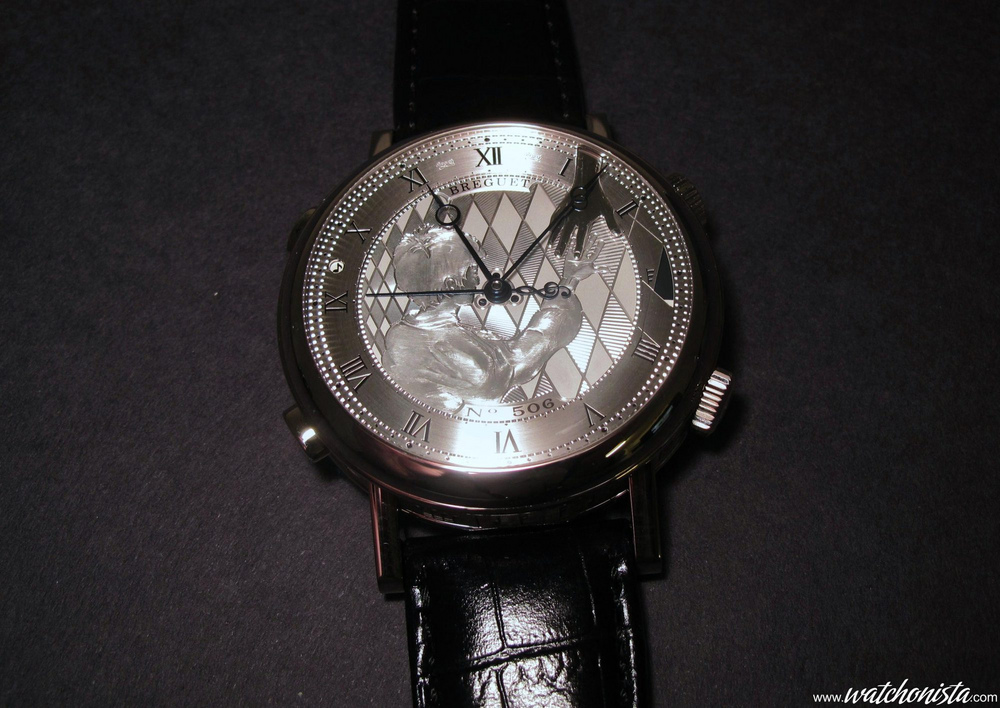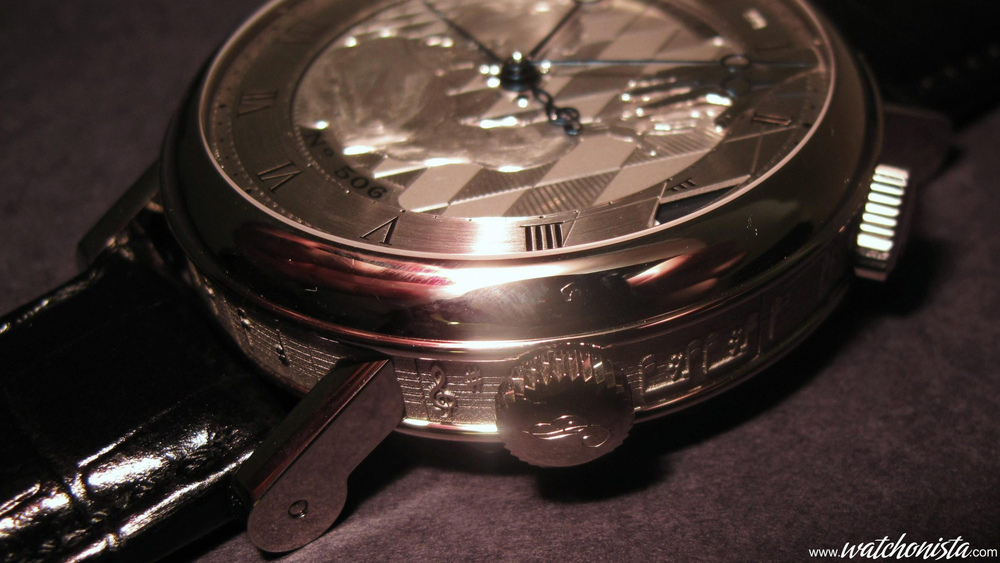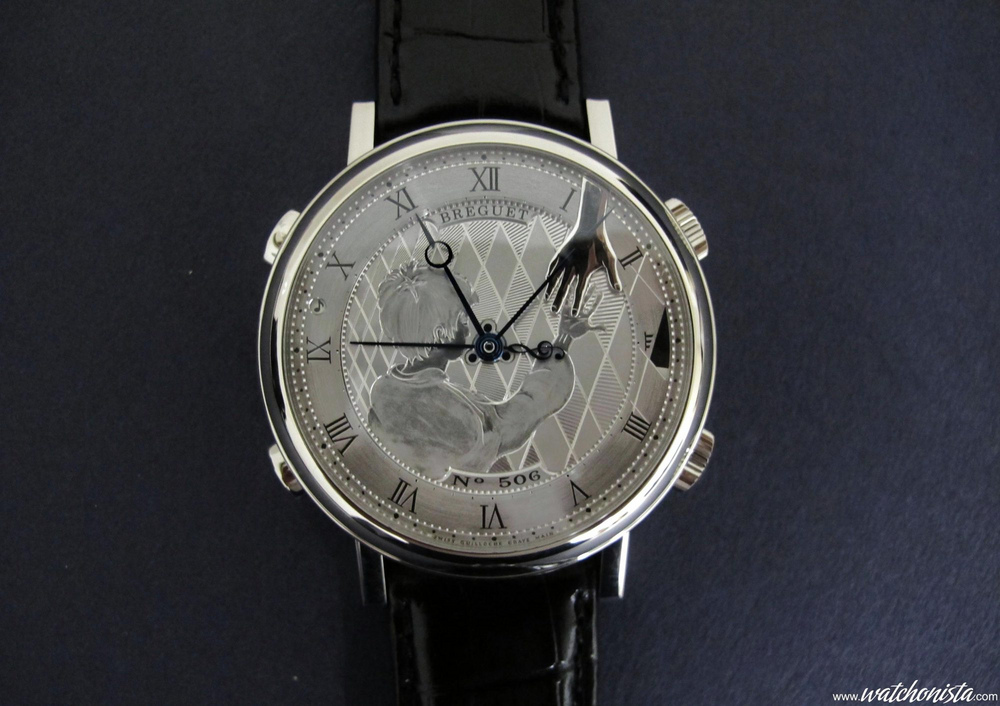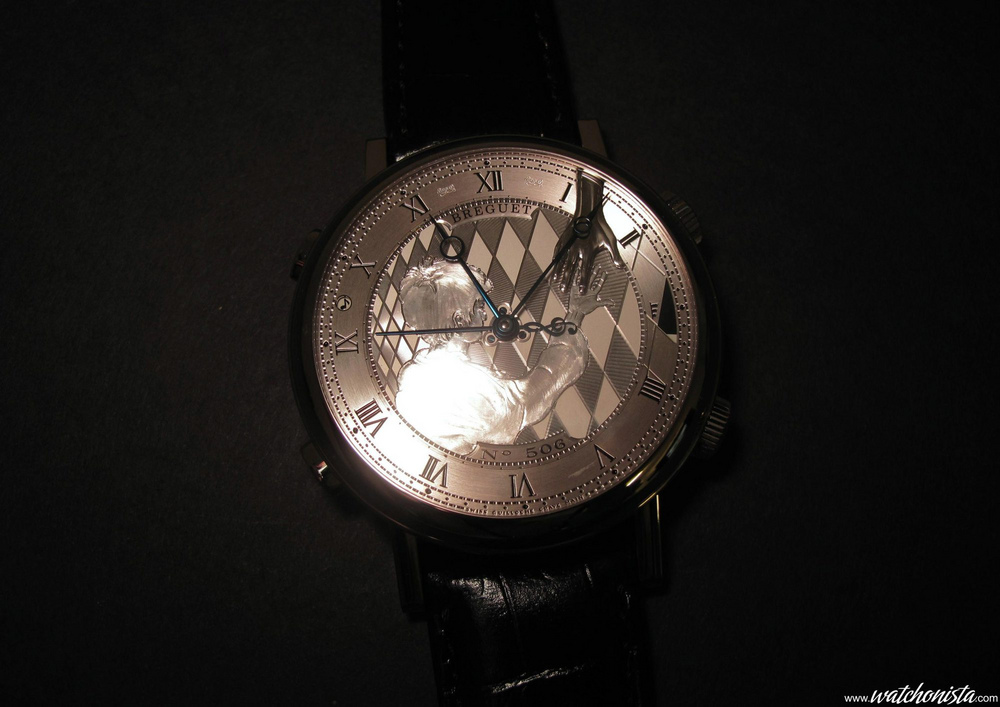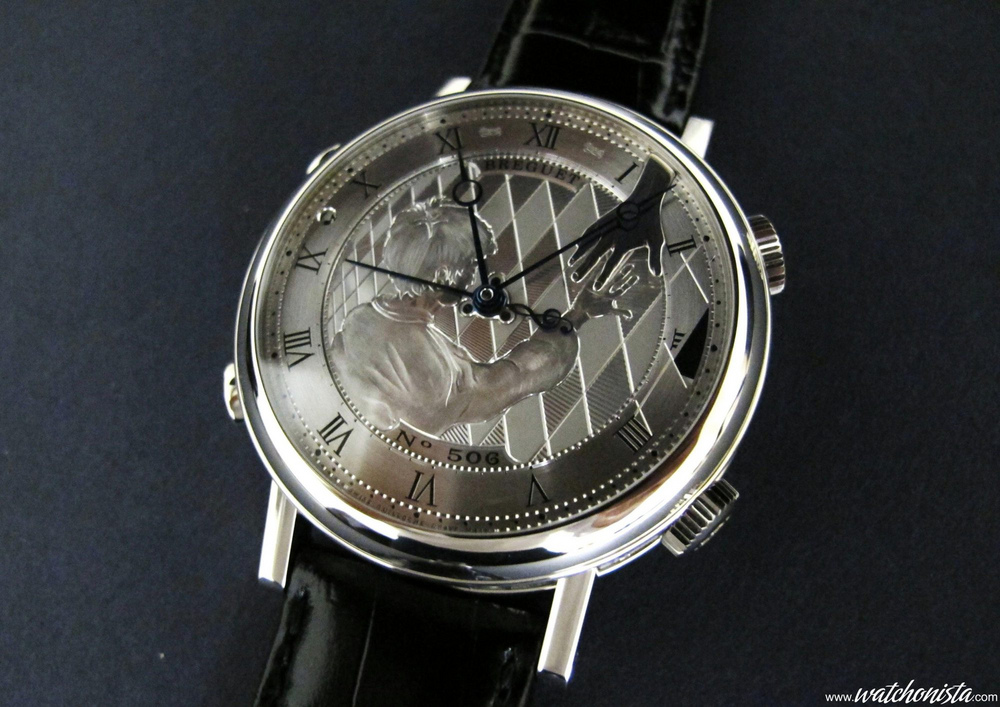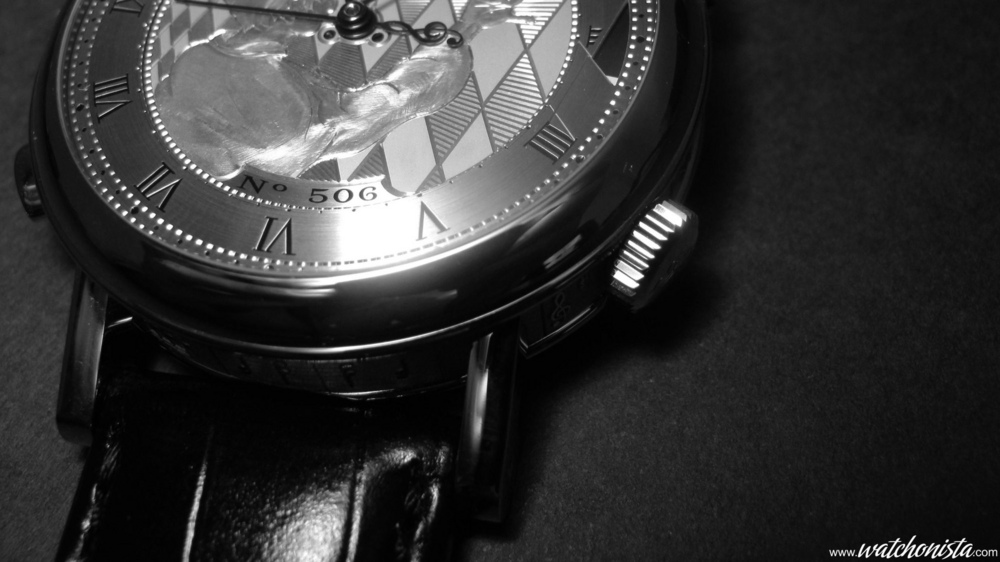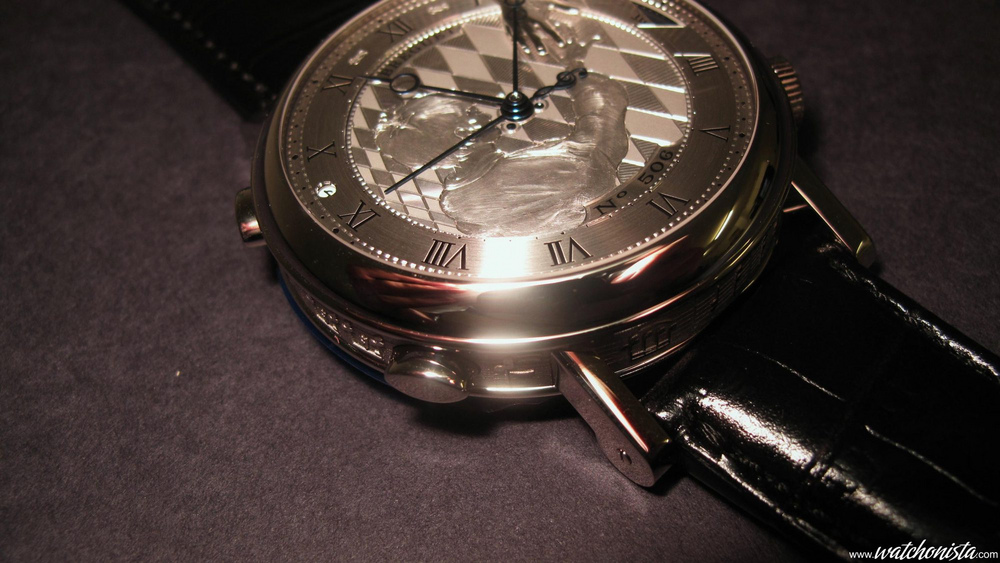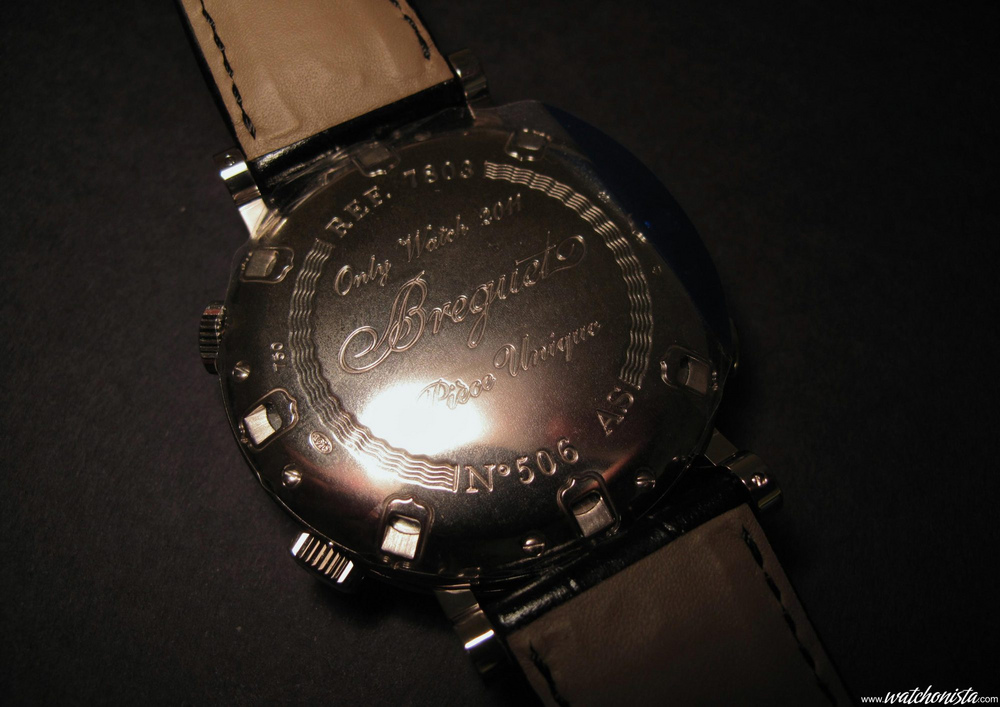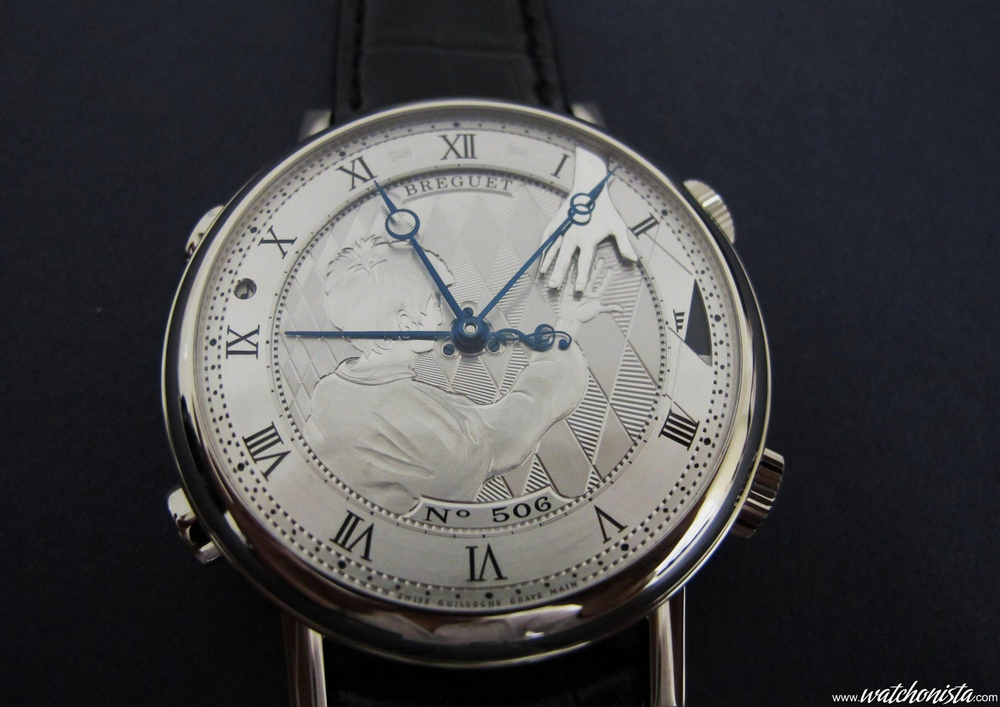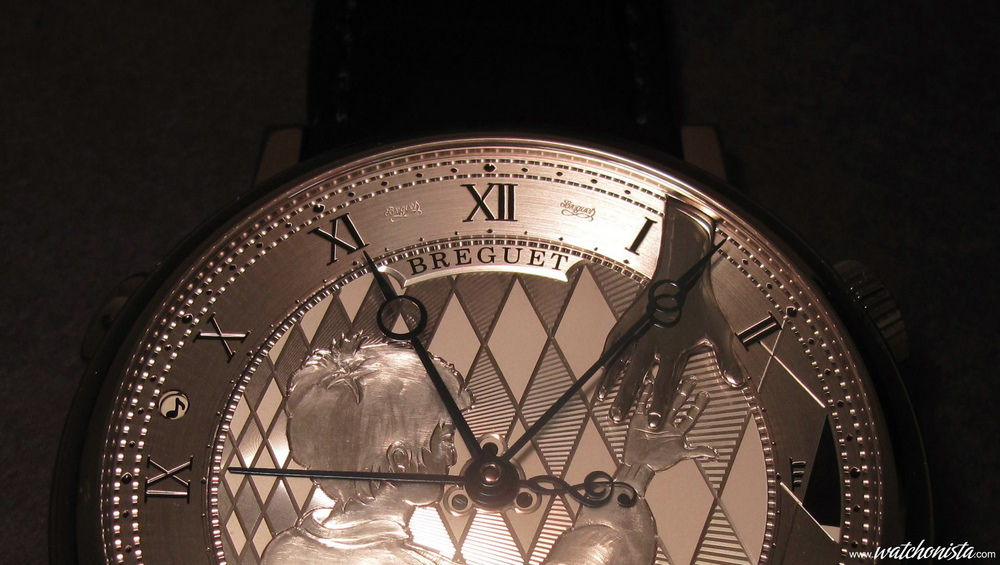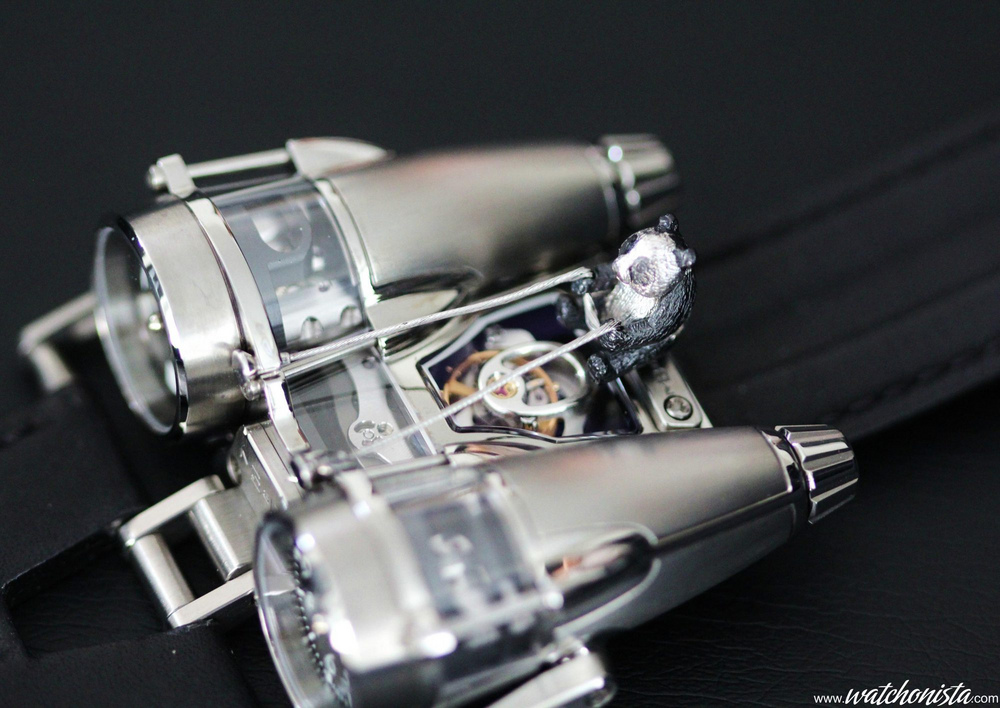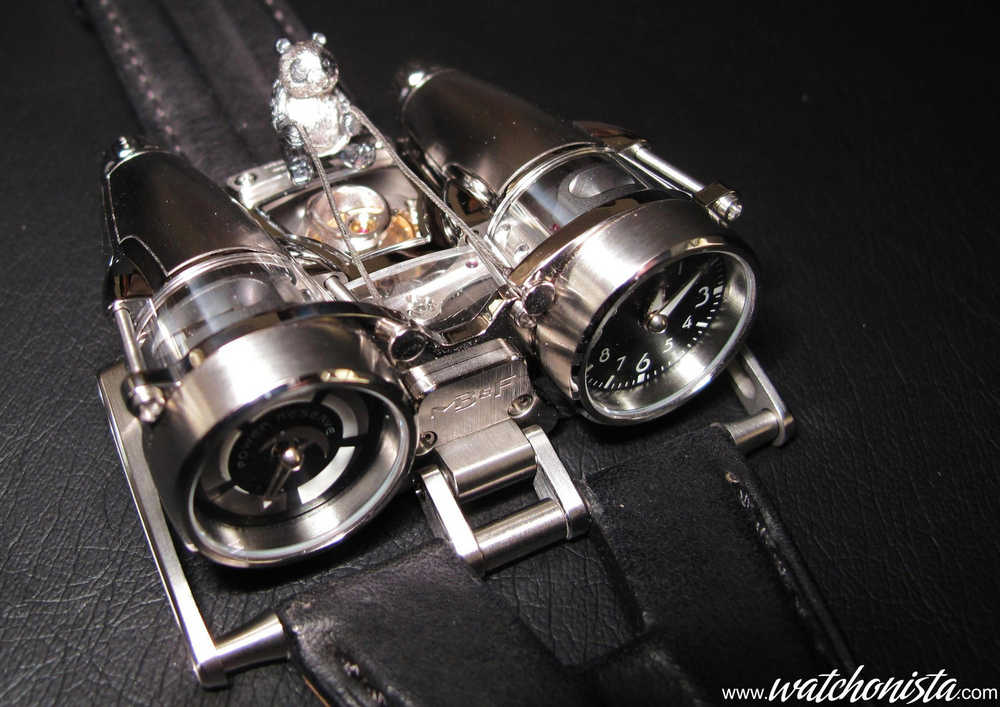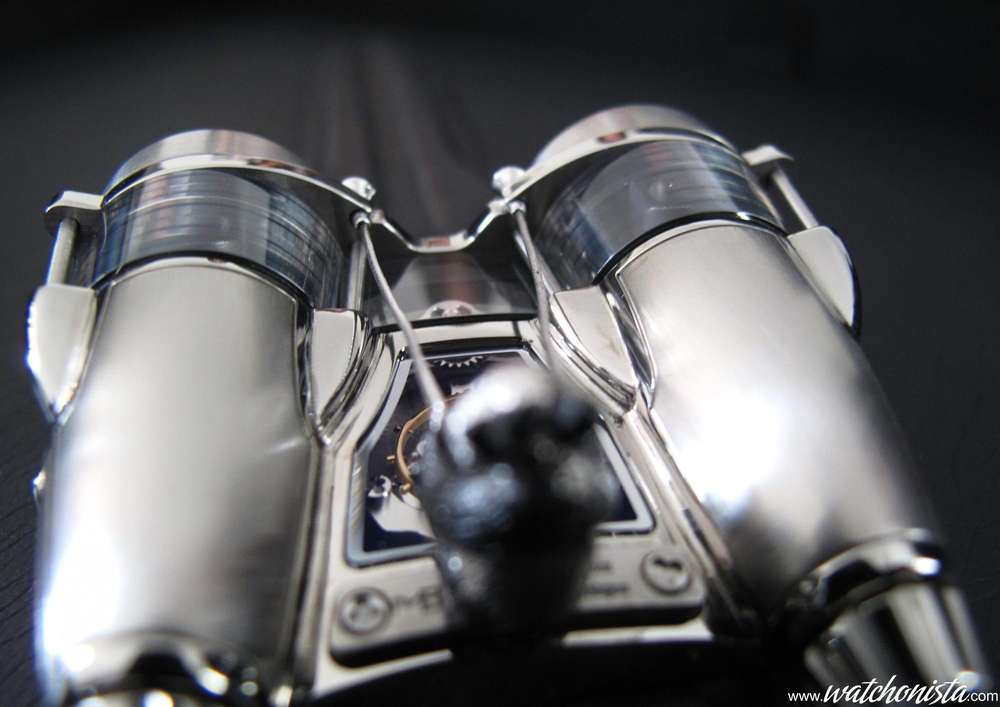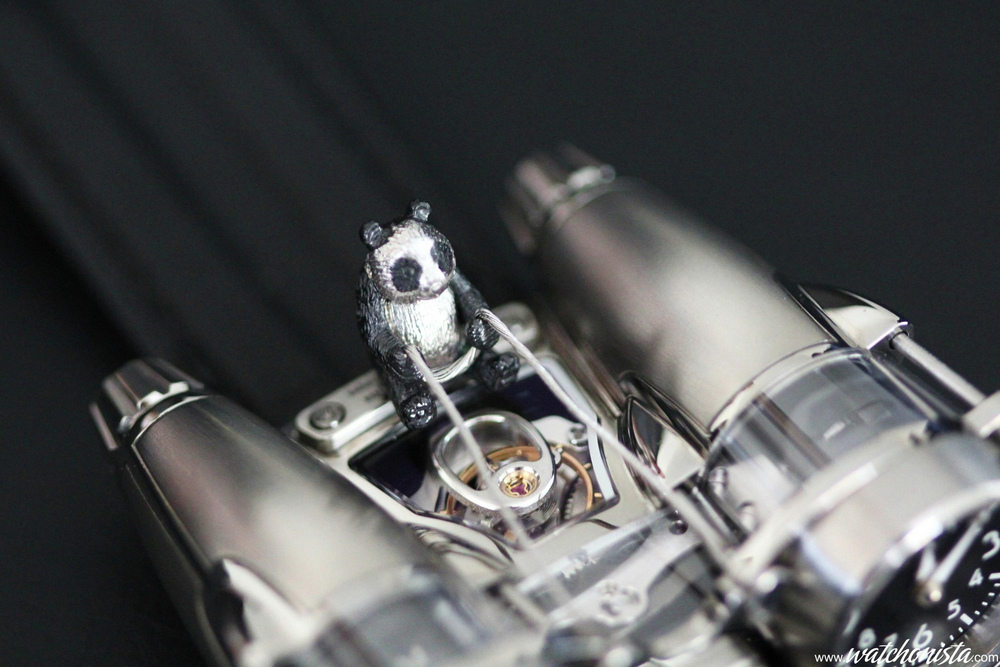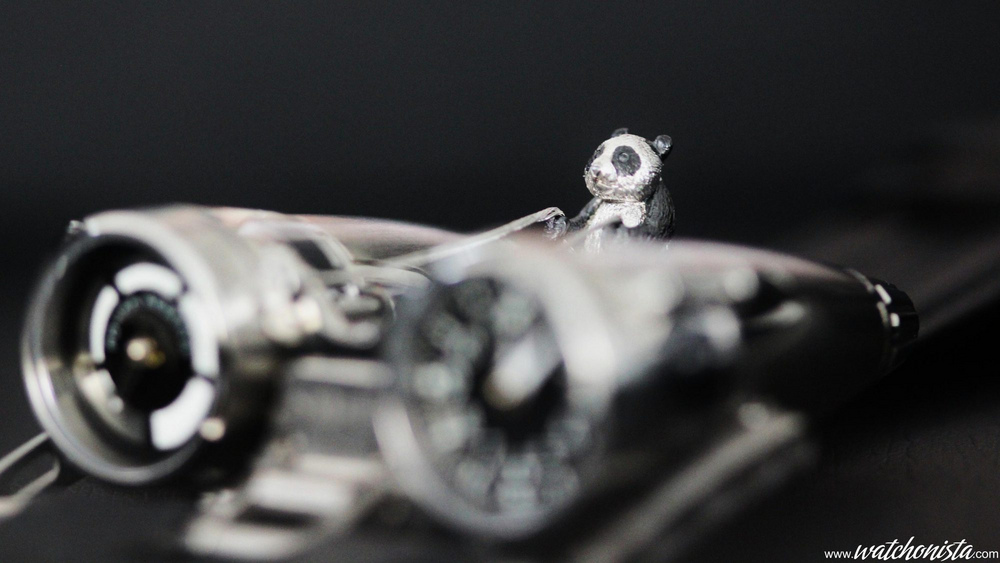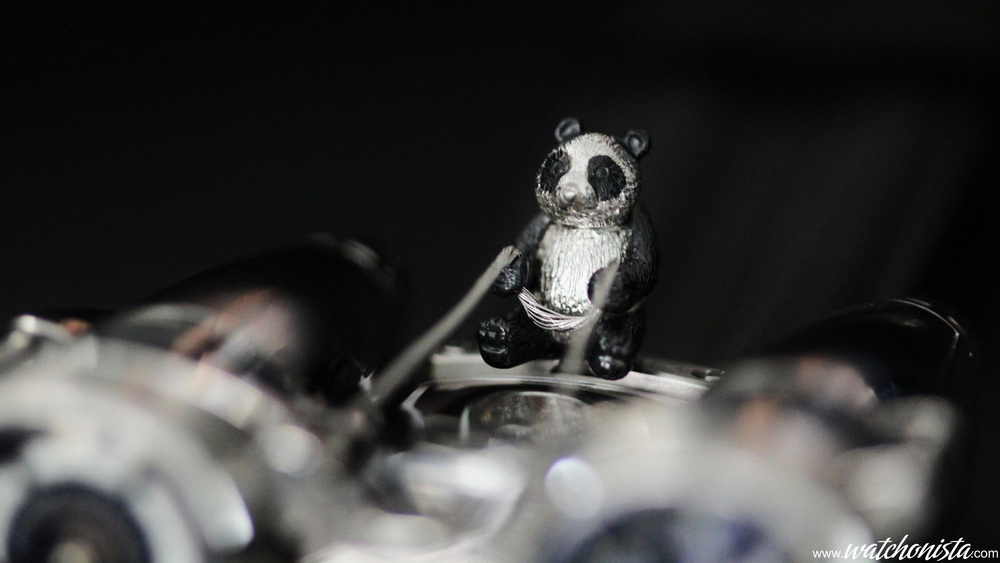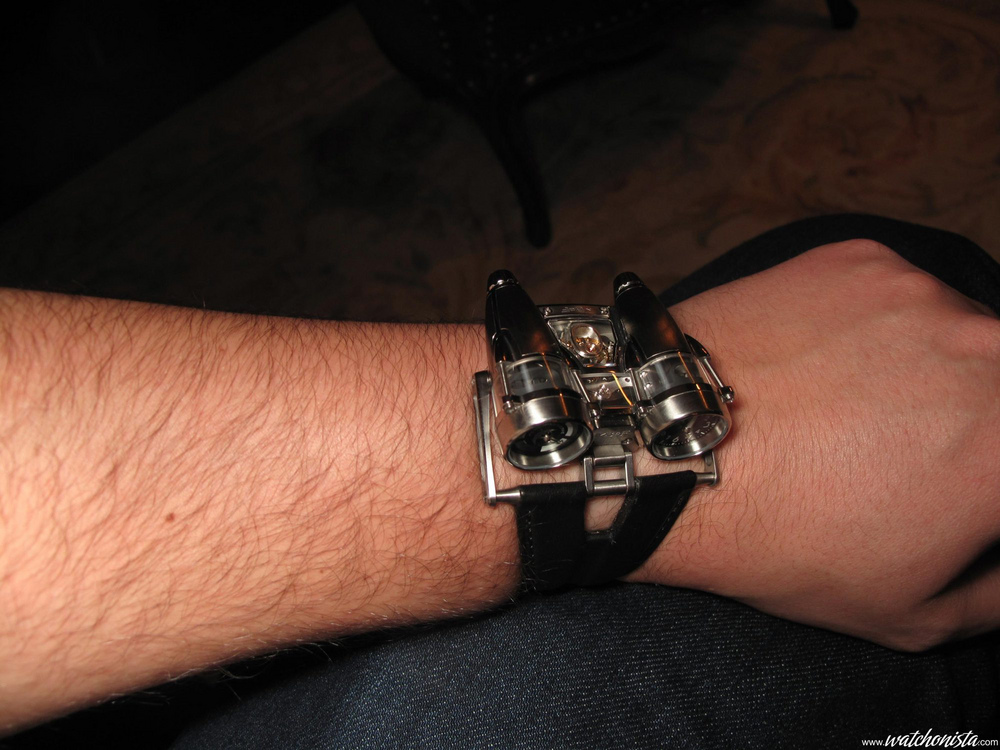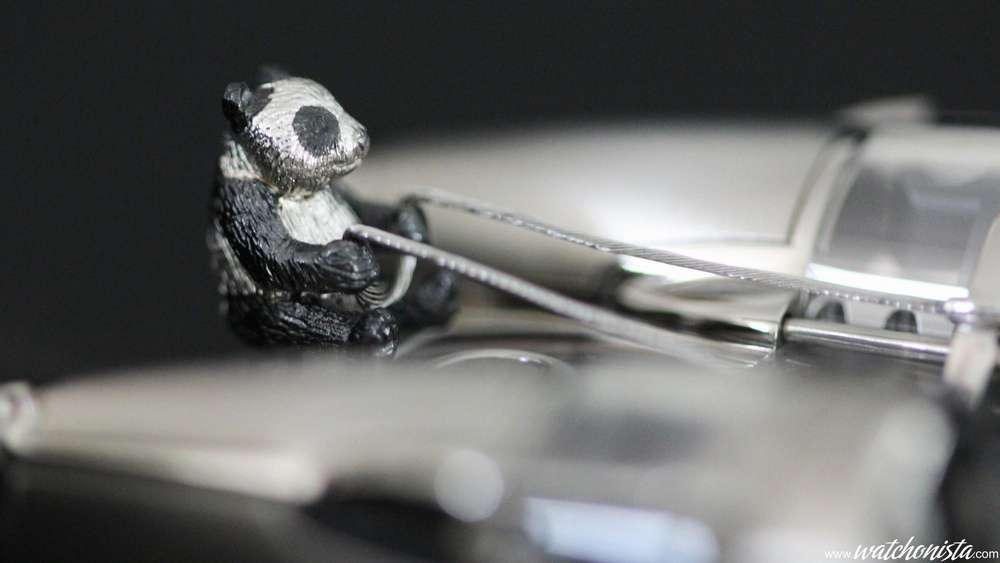These last months had become unbearable, I had the state of mind of a five year old on Christmas Eve.

At the beginning of November, a clusterf#ck about the delivery address made me blow a fuse.
After two extra weeks of waiting, (a kind of double penalty), the watch eventually arrived at the shipping facility in Geneva.
I jump into my Interceptor parked in Lausanne, for a homerun at « ISO 14001 driver’s license-revoking speeds”, punctuated by many front lights flashing aimed at placid Helvetians cruising on the Autobahn, themed after “the left lane, love it or leave it”!!

Touchdown. I make it at 6:27pm; the shipping company closes at 6:30pm. I furiously open the parcel, the attendant offers his rusty box-cutter (pardon me, shiny with age) that even a terrorist trainee would not use.
I retort: “Now, I’m ready”, drawing my 154cm Steel Leatherman, boasting!
Once the parcel stripped down like a Bobo after a trip to the Bronx in the 80’s, I get the monster out.
Detractors would say that it looks like plumbing pipes, but to me, since it is brand new and devoid of patina, or should I say “virginal”, it is unquestionably an outstanding ode to the classic elegance of the “Vegas pimp”.

-It is beautiful.
-Very beautiful.

Still, I remember that despite an inspired report on the SIHH2011, like “Zarathustra-stepping-down-from-the-mountain”, (Thus spoke Pifpaf), the PAM382 aka Bronzo did not arouse an unrestrained enthusiasm.
One could even say that it was lukewarm, or even cold.

Two reasons for this, the obvious one is with the festival of novelties, it was a little difficult to sort anything out “on paper”.

However, more deeply, many Paneristis still have whiffs of luxury classical watchmaking codes, with their stream of workmanship and timelessness ("You never actually own a Patek Philippe. You merely take care of it for the next generation", blablabla…).
And here, the OP signs a watch upstream from the classical views of the watch industry, because it is definitely a timeless watch, a piece totally embedded in the present and one that ages with its Panerist!
Worse or better! In the same way one chooses to smoke, to binge, to booze, to beat the crap out of people, the PAM382 aka Gonzo will age depending on its wearer’s unruliness.
Finally, one could write: « You will totally own this watch, we don’t give a sh#t about the future generations.”

The « vintage » trend started a few years ago, with the paradigm “the older the better”.
It is a wiener-contest of who has the most rotten, the scruffiest, and the stinkiest wristband (“fresh from the cow”, my dear Sir)…
But regarding watches, it still has to be shiny, involving the use of lots of « Cape Cod » polish; it has to be clean as a whistle.
Because the enemy of the genuine Vintage-roots-staining-gladiator-look is stainless steel, a fantastic alloy far too resilient to get a true patina! How scandalous!
Finally, the post-SIHH period during which Paneristis did not quite understand this watch, is the time it took to cross the psychological Rubicon of the “fine deluxe watchmaking” mythology.

Well, one has to acknowledge that with this PAM382 aka Swamp Thing (Thank you IMO), the Officine reached rock bottom, or the apex (depending on one’s point of view), in terms of trashiness.
It is bulky, it is ugly, it is green, it corrodes in 10 minutes, and it matches very few outfits and certainly not a suit. In short, it is the bomb.
In addition, it answers a profound expectation from watch fans, as an obvious parallel to watches from certain independents, Max Busser leading the charge.
We are bored with working for services companies who are totally out of touch with reality, one has to observe speed limits, put a suit on, shave, pay bills, taxes and insurances policies, sign divorce documents, brown-nose one’s boss, vote sensibly, not drink, not smoke, not get angry, not have sex (unless you follow rules of hygiene thick as the yellow pages), in short, we are experiencing the unprecedented rise of a sluggish totalitarianism.
Yet, this 382 aka “The Expendables” offers the uselessness, the insecurity, the discomfort of a necessary and vital transgression. This watch is 200 grams of carry-on freedom.

In short, bronze casting:
Regarding the exterior design, the PAM382 aka “The Gladiator” goes to the apex of the military-vintage concept. So vintage that the army extensively used bronze, 2700 years ago.
This alloy immediately reminds us of Steampunk, of Jules Verne and his Captain Nemo. However, depending upon one’s mood, it is closer to “The Gladiator” in terms of sensations when you wear it.
Because, fundamentally, the copper hat’s universe is the “Silent World”, the realm of contemplation;
But in this case, it is so brute, so virile, it aggressively goes for jugular so much so that one feels closer to being in the arena with lions than in the depths of the ocean with the fish (or else at the bottom of the Adriatic Sea with a pair of Santonis made of concrete).

The submersible line from Panerai is interesting, because apart from the bezel, which is a vague tribute to the Big Egy 2/56, this series is an almost pure avatar from the Richemont period. In fact, it is a kind of “in vivo” test of the Officine’s creativity and its vision of Panerai.
The 24-25 was almost the worst the Officine could do in terms of design and finishes. Then the Bombas came out, and next the Submersibles 47mm, and we pretty quickly got into a universe ruled by technique, a consequence of the restrictions due to diving regulations, requiring quite a lot of compromise from an historic standpoint.
Afterwards, the PAM305 took precedence over the superb but vulgar former Sub 47mm. While the level of finishing and the caliber are praiseworthy, the overall result is plain, maybe even cold, in an attempt to avoid tackiness.
This year the Officine finally proposes mature Submersibles, with the 371 and the 382, thanks to the addition of just the right amount of color.

The revolution in this Submersible is not so much the use of bronze, many brands did it over the last 30 years: Genta, Anonimo, Cuervos & Sobrinos, etc… No, the revolution is to have gotten bronze out of the ghetto of cheap brands.
It is the fact that the Officine managed to transform bronze into gold with a design and a product consistency unreachable to razzie awards regulars. Akin to Technotime, which is struggling to find prestigious customers to match the quality of their production, the bronze metal was not heralded to the level it deserved.

[Panipedia]
The bronze CuSn8, after its German designation (Willkommen in die Suisse Romande ! It is called C52100 in the USA or CuSn9P in France), is a 92% copper and 8% tin compound.
It is one of the bronze alloys that features high resistance to corrosion and is only slightly allergenic (or even “food grade”).
After one month of heavy use, I experienced a slight itching in the area of the crown guard , unless it is a side effect of the Helvetian winter on my skin.
One has to say that, thanks to the domed case back, neither the lugs nor the case touch the skin ; The aftermarket Di Stephano bronze buckle causes itching from time to time.
Again, regarding comfort, the watch is heavy, but the density of bronze is very close to that of stainless steel (9 instead of

, hence if the weight difference is noticeable compared to scrawnier watches, it remains within the standards of 47mm Subs.
The piece weighs around 200 grams with its wristband, it is heavy, but still, the watch is comfortable given its size.
But if you have a frail wrist or if the strap is ill fitted, you simply do not deserve to wear the same watch as Sly.
This alloy is somewhat the equivalent to 4N rose gold, not the most exotic variety, but the most stable and proven one.
Nonmagnetic, its hardness is around 150 Vickers, between 18K gold and steel.
By the way, I just put a #*$ ¤% dent on the bezel, indeed, it is really not the hardest of metals !
Copper, which accounts for 92% of the case, is one of the metals, if not the metal most widely used in watchmaking, for ebauches made of nickel-silver or brass, and for turned parts. Copper is regarded as the noblest metal behind precious ones, thanks to its ductility, its resistance to corrosion as well as its good conductivity. Above all, it is one of the rare golden/salmon colored metals, with an offbeat and warm look, in the middle of an ocean of metallic grayness.
[/Panipedia]

Bronze is much warmer than titanium, and the watch looks bulkier, hulkier and impossible to forget in everyday life !
Bronze softens angles, the Bronzo looks more rounded than the PAM305.
The curved outlines of the 1950 case reaches yet another dimension with bronze, the patina emphasizes the curves better than titanium or stainless steel. The alliance between new metals and new case designs promises great things for the years to come. How could we live for so many years with only steel Bettarinis?
The Nautilus-looking bezel (from « Pimp my Submersible feat Nemo », not « Da Pa-teK by MC Genta ») is the centerpiece of this watch, it gets a patina fairly quickly and the polished “Paris nails” indexes show up like gold choppers. Thanks to bronze, the bezel looks less flat that the 305’s, one almost returns to the pitbulian feel of the Bombas, with extra comfort. Regarding the bottle-opener, because of the low contrast between the bronze and the color of the skin, it is far less noticeable than on the other 47mm Luminors.

As for the aging, with normal use, it takes several years to get a greenish watch. On the “dotcom”, some put it in water, or even seawater, in order to quicken the aging; here it is a matter of choice, as I said earlier, it is a personal watch, but first and foremost a customizable one!
For that matter, if green is the natural color of oxidized bronze, this alloy can take almost any hue, depending on the acids used to attack the surface, as sculptors do. (Pifpaf disclaims all responsibility in case of inadequate use of your Gonzo).

Akin to the utilization of bronze, the design of the dial is a first for Panerai as well as a rarity in watchmaking.
Green is totally under used in dial making, and even if it is the historic color of Rolex, very few watchmakers offer it, red or orange dials are far more common… Green is the color of aged bronze, but it is also that of foliage, in which grunts love to hide. This shy species never stops painting tanks and fatigues in green.
This reference to military camouflage uses a shade similar to the famous GMC CCKW 353 (Gogol is your friend).
Akin to the 371 with its blue dial, green brings far more dynamism than the black used on the 305.
According to a care for detail that is symptomatic of the increasing level of quality of the OP, the date disk is also green , and the Luminova unquestionably fits the watch perfectly.

The 4mm thick sapphire is the same as the PAM305’s, it is effective, and it distorts just enough to remind us it is a dive watch; One could regret the lack of an internal magnifier for the date, but I am not willing to gain 2mm in thickness « just » for that.

The only dark spot is the hands: they are golden (brass ?), which is consistent with the overall look and feel of the watch; Less consistent is the fact that they are hollowed out. If one quickly gets used to it by day, it is far more complicated by night, as the dial is less flashy than many “Panis”, and therefore one ends up deciphering multiple poorly contrasted luminescent dots. Not great for telling time while driving, for example.

Then, when turning the watch over, one finds a sapphire back, rimmed with a titanium ring , a material that prevents allergies. For once, the transparent back is welcome, because a full titanium underside would not have brought much to a bronze watch.
First, one has to specify that an automatic caliber is mandatory per dive watch regulations, hence the choice of movements is obviously limited.
The watch is fitted with the P.9000, without the PAM371’s power reserve; However, this movement remains a big effort by the OP compared with the castrated 7750 fitted in the previous Subs.
It is an interesting caliber, which features a layout close to the P.2000 series, with only two barrels for a theoretical 72-hour Power-Reserve (at least 75 actually, or even more, I could not stay away from the 382 any longer ).
The balance is set at a standard 28800 v/h. The overall dimensions are also common, with a diameter of 13 lines and a thickness of 8mm. If the dimensions of the P.2002 are the same as the 7750, the Officine could have produced a thinner and wider caliber, akin to the P.3000. Still, it is a very bulky movement compared to a regular 28-XX from ETA.
One has to understand that it takes years to develop a caliber, and that the 40mm PAM usually accounted for most of the sales.
The decoration is well executed, without flourishing and perfectly suited to the spirit of what a Panerai caliber should be; One could regret the somewhat offbeat trimming (especially the hollowing of the rotor’s counterweight, worthy of a MB&F), which has little to do with the vintage look of the watch; anyway, to keep nitpicking so vehemently is to be assured to get into trouble with the ASPCA.
It is a consistent choice however, since there are very few alternatives. Nobody proposes a larger automatic movement (the TT738 from Technotime is thinner with similar technical features).
Regarding the accuracy, there is nothing to complain about, akin to many industrial calibers from groups, it is always outstanding, with less than a one minute recorded deviation over this first month (a gain of about one second a day).
This almost « In-House » mechanism (designed and assembled at Val Fleurier), « Group made » anyway, offers all the comfort one can expect from a costly watch.
The Bronzo is delivered in a marine clock like box to die for, and if the quality of OP boxes always meets expectations, this one is exceptional: precious wood, bronze plate and key, in short, it justifies the price of the monster.
On the contrary, the supplied straps are more than upsetting: a ghastly brown hide and the utterly unattractive sail canvas wristband (why not the superb pleated rubber strap of the 305?); Furthermore, there is no matching bronze buckle. As Nature abhors a vacuum, strapmakers make up for it, (straps were delivered long before the watch).
The large green strap on the photos, like the “tanned-Hulk-skin”, is a calf nubuck “Maiala” from Mustang Straps (I am also waiting for a green canvas, to perfect the “Band of Brothers” look).
The seamless « Gator » is a Simona Di Stephano. After lots of testing, the watch works better with dark green or brown
straps.

This watch, akin to the PAM339 from last year, is a turning point for the OP. Because with these kinds of designs, the Officine does better than to revisit the 40’-50’s hits with more or less success, it transcends the codes of vintage in order to present a nostalgic and (therefore?) ultra-transgressive product.
A perfect split achieved with brilliance. For that matter, it is a fabulous nose thumbing, when Hublot or other brands propose High-tech everlasting materials, used in State-of-the-art weaponry (the Boron carbide used in the Magic Gold is usually utilized for armored-plates). Conversely, the Officine proposes a watch made of a copper alloy, the Bronzium

, a High-tech material 5000 years ago. The Future Primitive.

) i don't like very much the bronze case, but the Submersible is a nice and profesisonal Sub! The Sub. of post is very beautiful with the brown strap...is perfect!
We waiting you also after the next SIHH!



 The
The 











 , hence if the weight difference is noticeable compared to scrawnier watches, it remains within the standards of 47mm Subs.
, hence if the weight difference is noticeable compared to scrawnier watches, it remains within the standards of 47mm Subs.







































































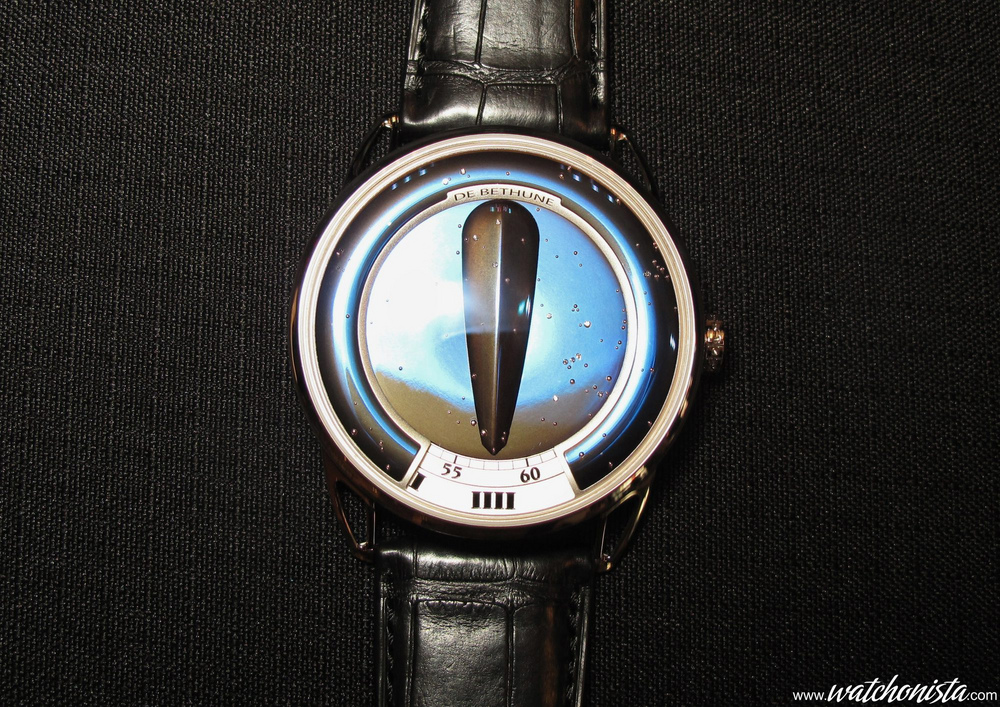

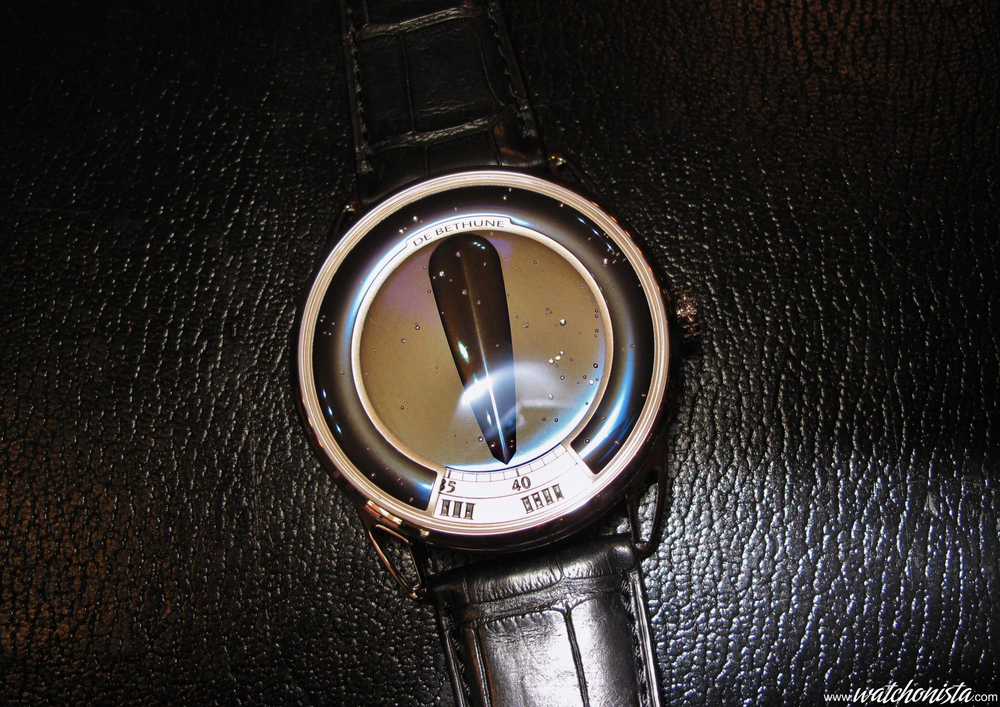
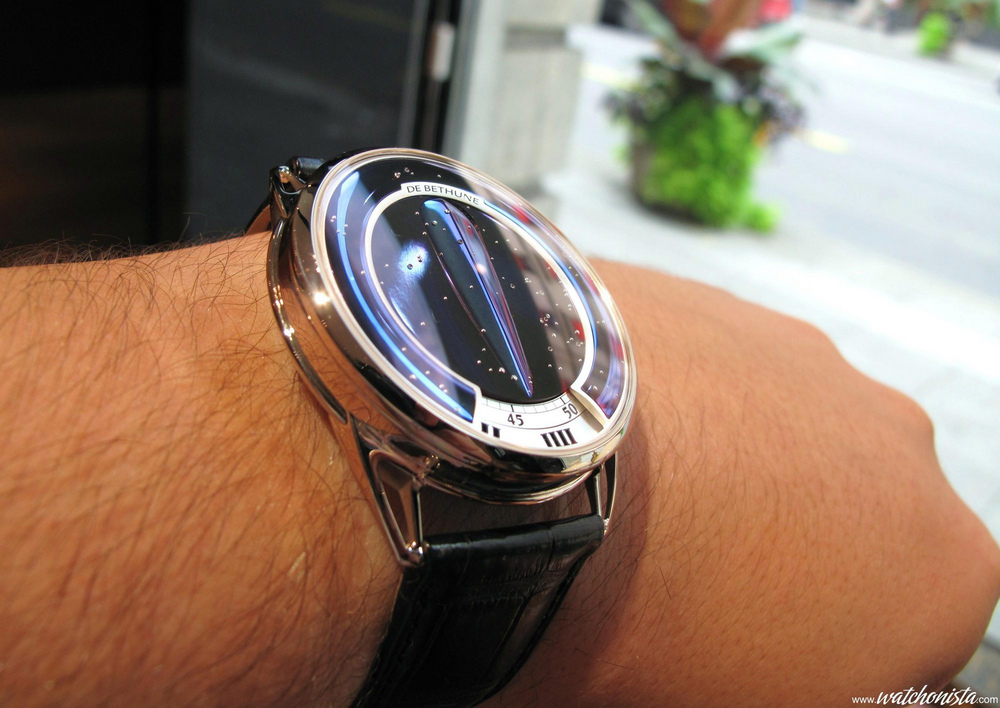
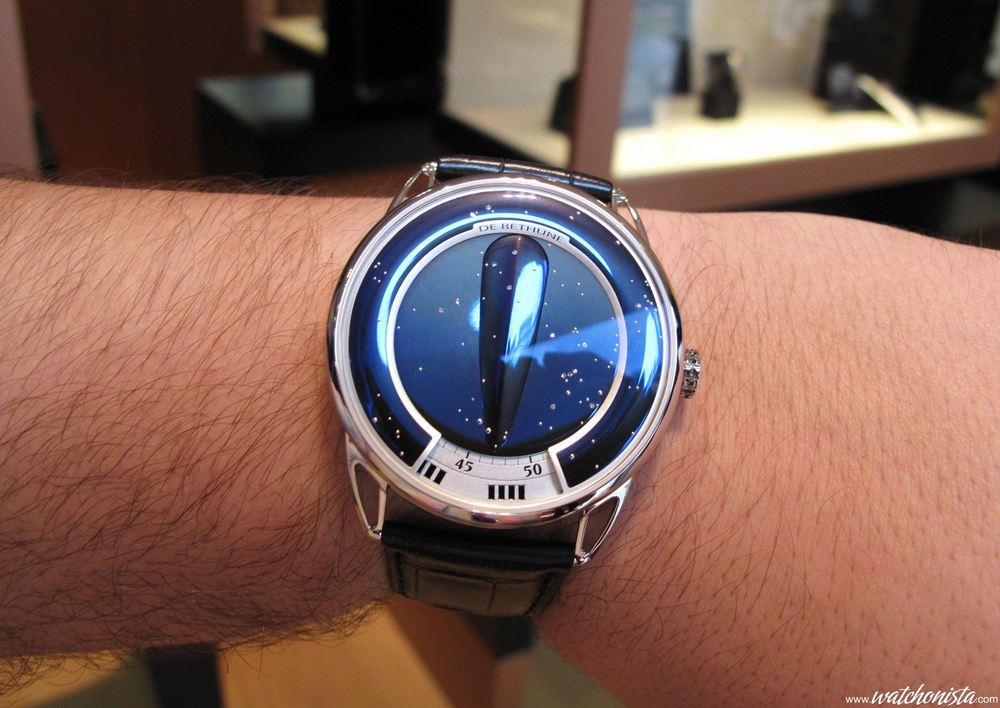
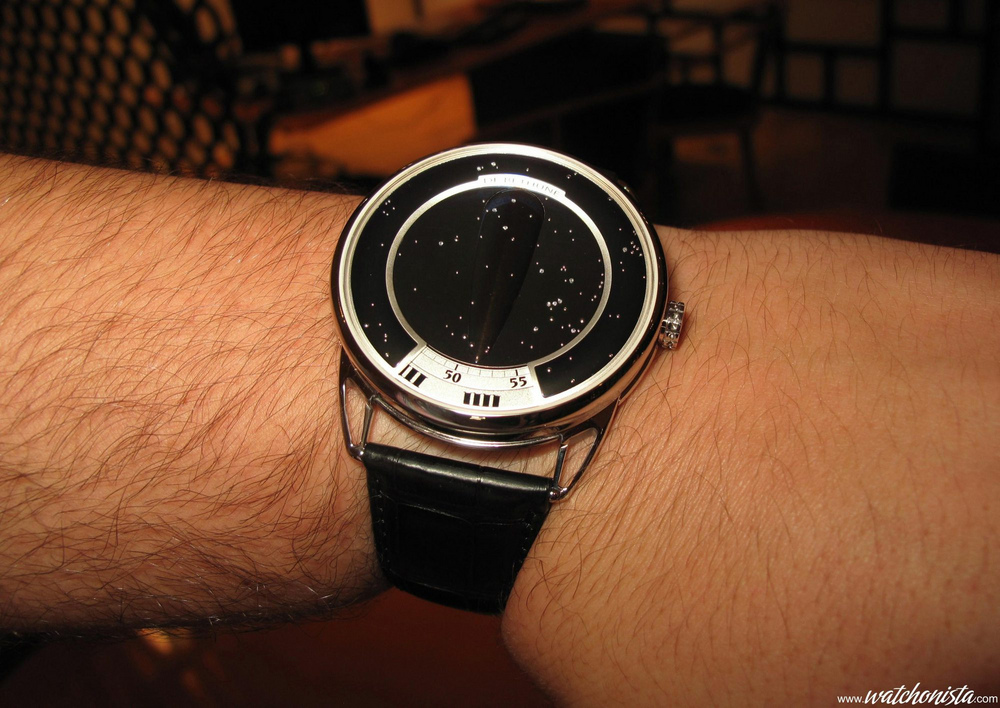

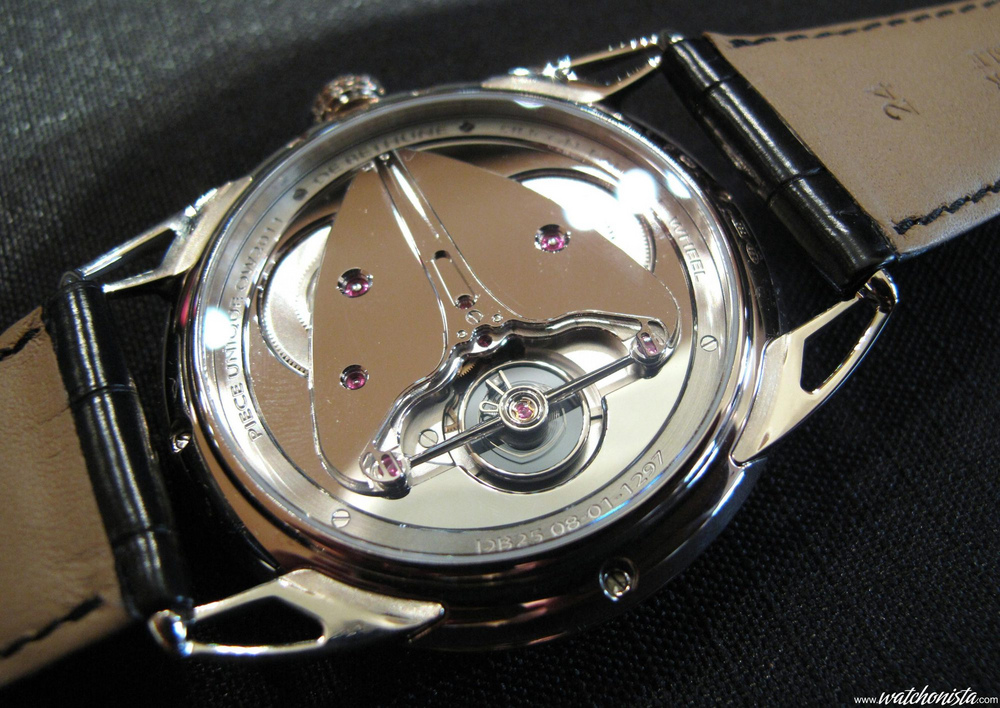
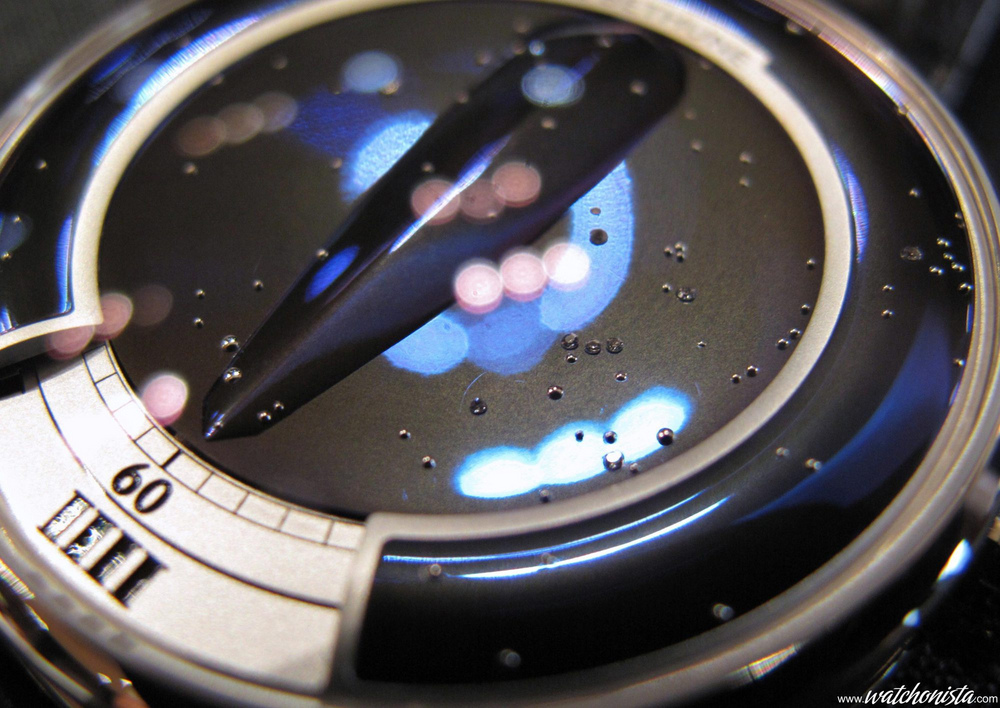
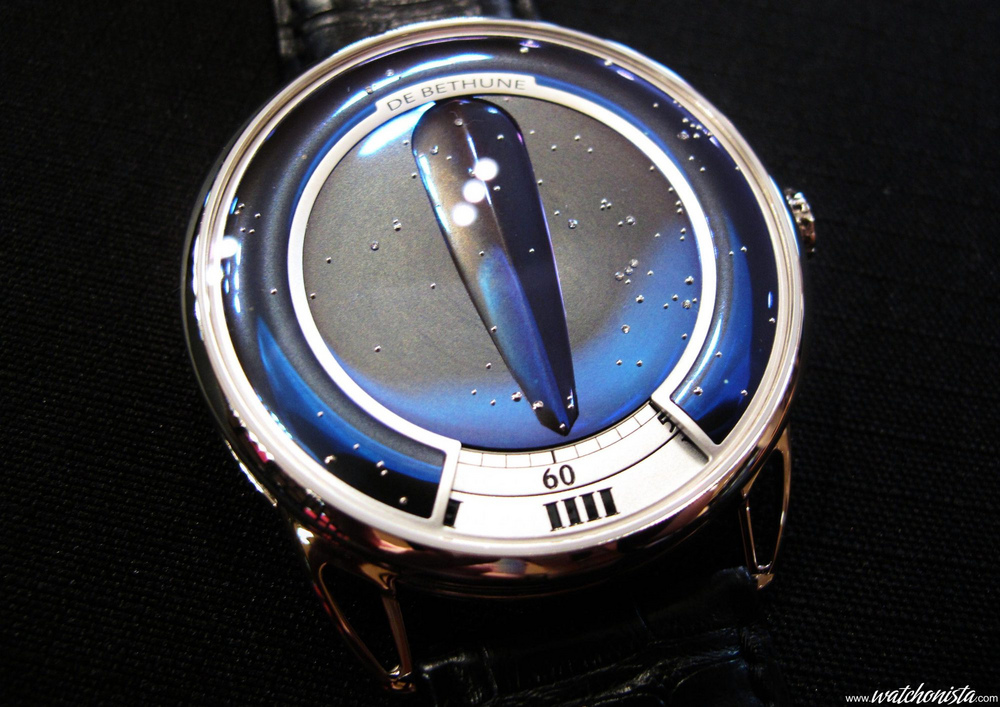

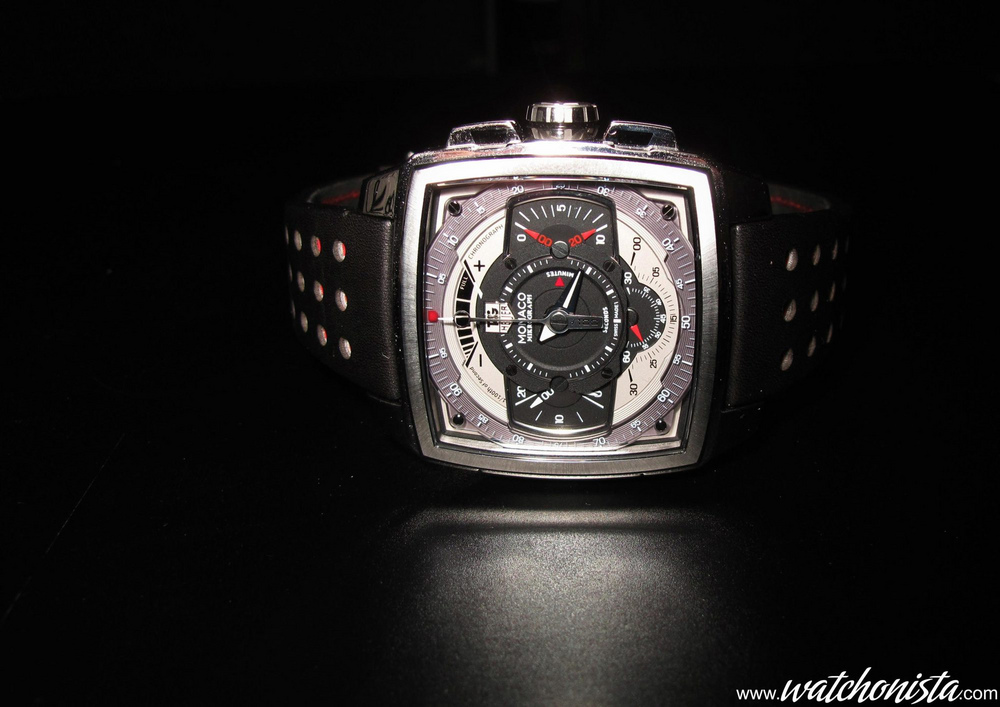
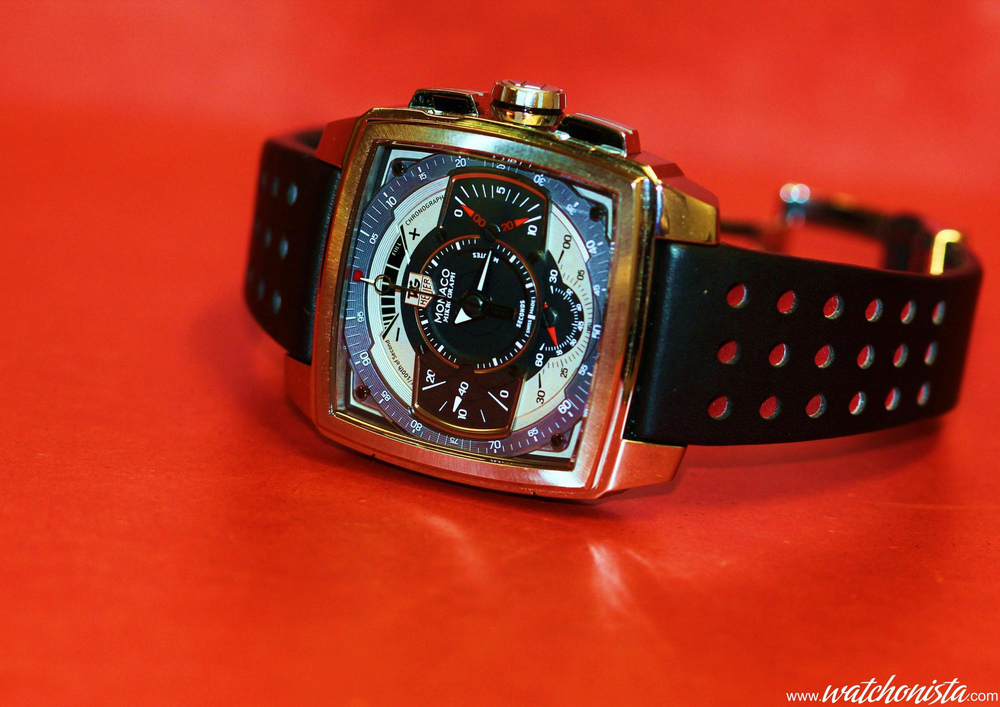
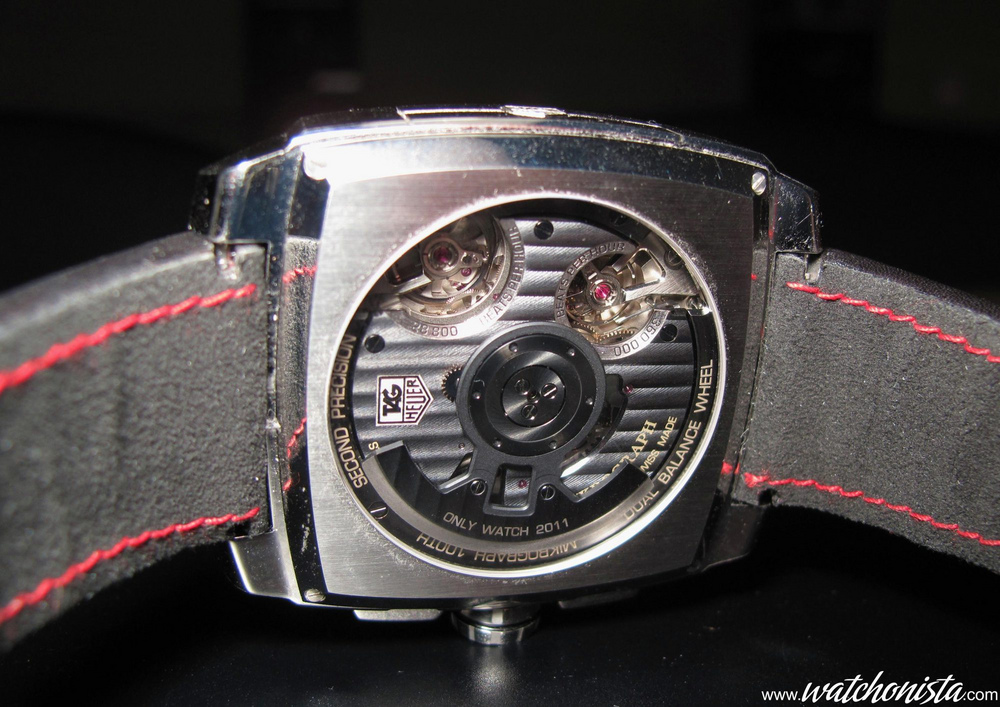

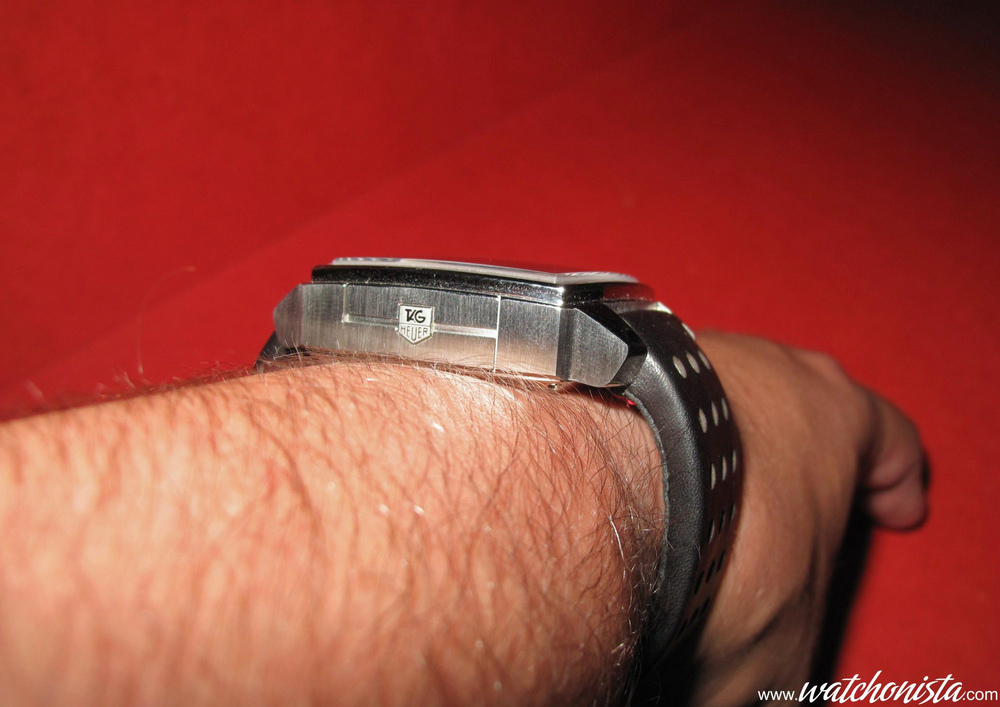
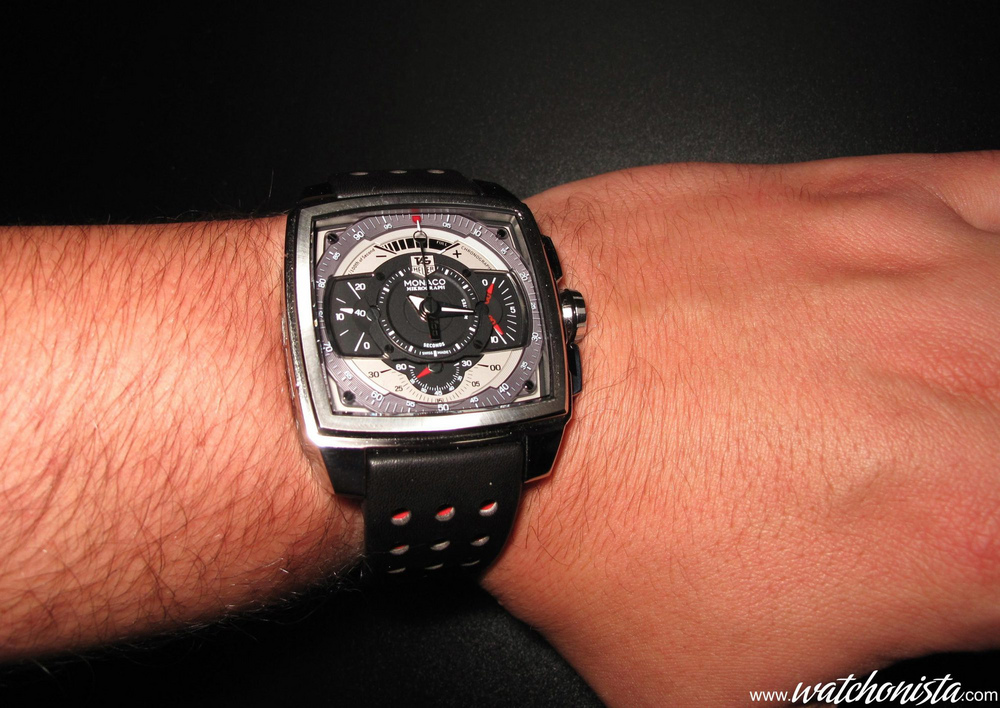
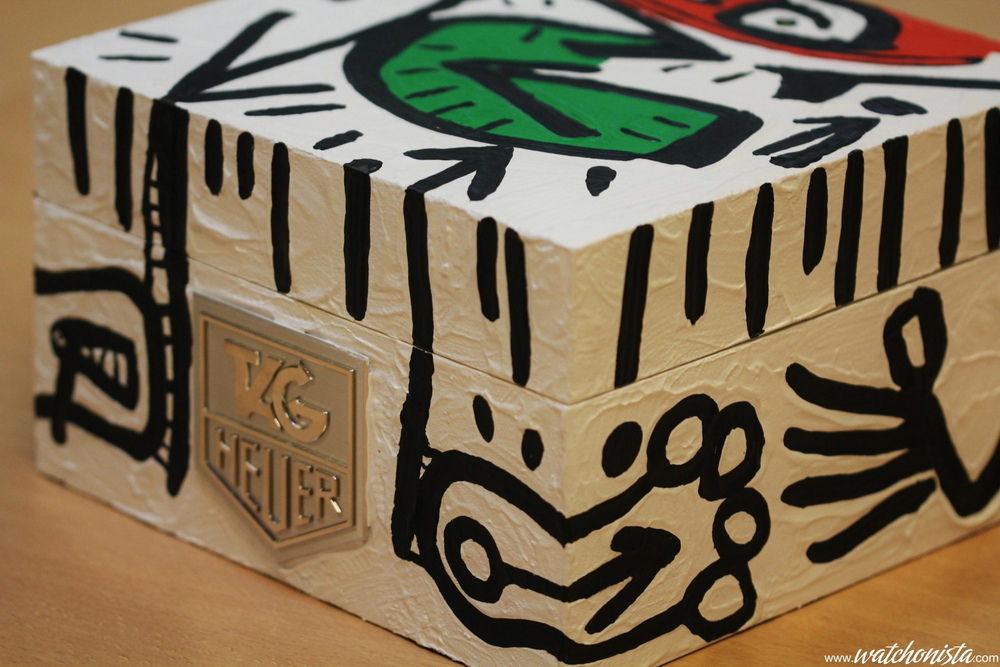
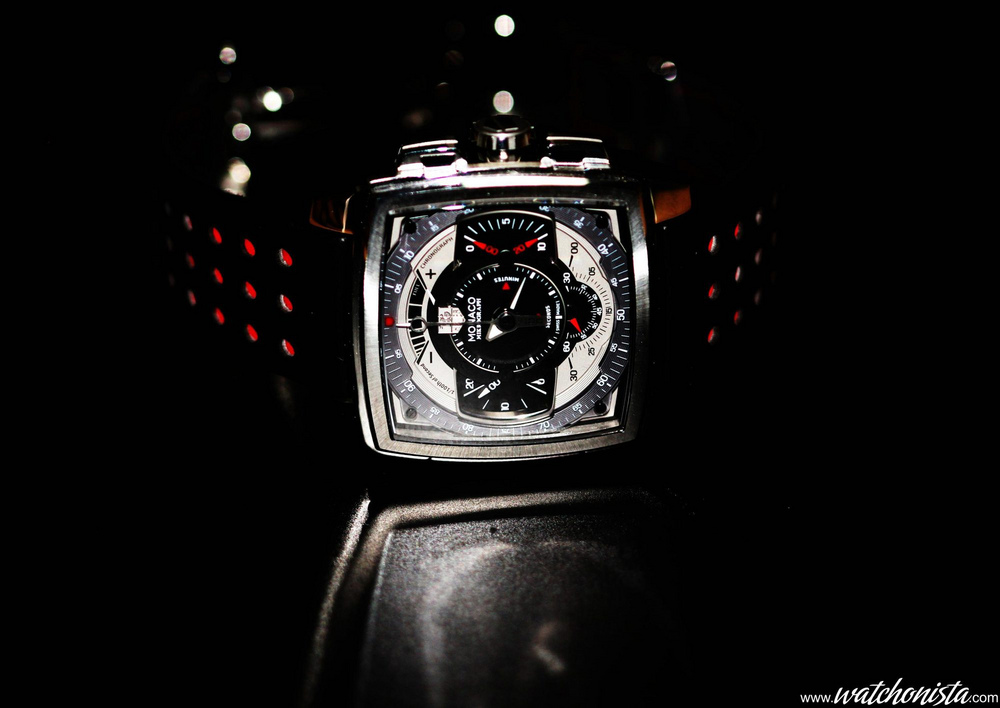

 gmail.com
gmail.com




